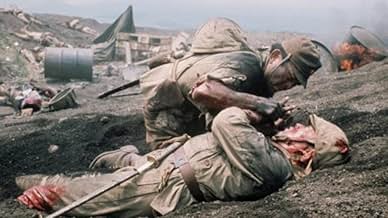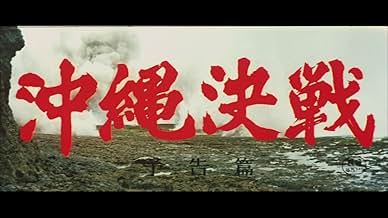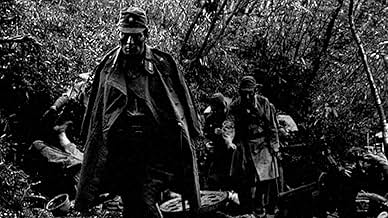AVALIAÇÃO DA IMDb
6,9/10
505
SUA AVALIAÇÃO
Adicionar um enredo no seu idiomaTold from the Japanese perspective, this war drama captures the events of World War II's Battle of Okinawa - a massive amphibious assault by U.S. troops that left more than 150,000 Japanese ... Ler tudoTold from the Japanese perspective, this war drama captures the events of World War II's Battle of Okinawa - a massive amphibious assault by U.S. troops that left more than 150,000 Japanese civilians dead.Told from the Japanese perspective, this war drama captures the events of World War II's Battle of Okinawa - a massive amphibious assault by U.S. troops that left more than 150,000 Japanese civilians dead.
- Direção
- Roteiristas
- Artistas
- Direção
- Roteiristas
- Elenco e equipe completos
- Produção, bilheteria e muito mais no IMDbPro
Avaliações em destaque
The film is pretty bad across the board. Even ignoring the poor special effects due to budget, the direction and editing is poor. A tighter script and decent editing would have done wonders for what could have been a good film. The story line is grim, of course, but is badly handled and is an emotionless tale of waste. To get an emotional response from an audience you need to care about the characters, and that empathy is what the movie truly lacks. The film is a docudrama, but lacks drama and the power of a documentary. It's worth a look, but is certainly not a good film. Compare BoO with Story of a Prostitute, Fires on the Plain, or The Burmese Harp, and you'll understand why it is a forgotten film.
Chronicling the bloodiest and most pointless last stand of the Pacific Theatre, The Battle of Okinawa is far more well-known nowadays for essentially giving Hideaki Anno his career. Told in a quasi-documentary-like format, with black and white newsreel footage juxtaposed with narration from Kiyoshi Kobayashi over the dramatic scenes, Kihachi Okamoto manages to expertly balance horrific authenticity with few artistic liberties taken along the way. It's a film that captures an essence of bravery, lunacy and hollow childlike subservience, as well as the sheer devastating horror that gets increasingly desperate and progressively violent the longer it goes on, the final 5-minutes alone comparable to the likes of Saving Private Ryan in its entirety; Okamoto pulls no punches in the graphic details with his cynical, dark sense of humour coming out in full force. With incredible performance from its cast, most notably Tetsuro Tanba and Tatsuya Nakadai, a fantastic if limited score by Masaru Sato and energetic direction, The Battle of Okinawa is an incredible epic, one of exhaustive and continual bombardment that takes no prisoners leaving the camera smeared with blood by its dramatic end.
I'm really surprised at the positive reviews this film has received and the high IMDb rating. Reading them at times I wondered if we was watching the same movie. I'm going to have to disagree with the other reviewers and say that the film doesn't work, either historically or dramatically.
Historically, it's wildly inaccurate. The whole movie suffers from the need to portray the Japanese in the best possible and most heroic light. A few examples: by April, 1945, the Japanese pilot corps had been almost totally destroyed. The Japanese were unable to train new pilots at the rate they were being killed. This is one reason why they resorted to suicide attacks. And yet we are to believe that large air forces still exist and were not employed in Okinawa because the army was unwilling to attack the American forces and recapture the air fields to the north. Another example is the Yamato. The Japanese Navy in the north had been almost destroyed, and what remained lacked fuel, but the admiralty felt the need to make some sort of gesture and sent their largest battleship. The plan had always been to beach and scuttle the ship on Okinawa and use it as a gun platform, but instead we are told that it's mission was to bravely sail amongst the Americans and fight until it was out of ammo. Unfortunately before she could do that, she was attacked by those dastardly Americans who flew gigantic squadrons of planes against her (100 planes attacking a single ship at once?). What tripe.
Unlike movies like "Tora Tora Tora" or "Midway", there is no attempt to personalize or portray the other side as anything but mindless, bloodthirsty automatons. The Americans are shown as surprisingly weak, unable to cope with the Japanese in hand to hand combat, and most of the Japanese appear to die by artillery fire or mowed down by tanks. It's the kind of chauvinism one would expect from a John Wayne movie.
Now, I don't expect historical accuracy from a John Wayne movie, but I do expect it to be entertaining. However, this movie is just too confusing and poorly written. Worse of all, it resorts to melodrama. I lost count of how many times women and children were used to manipulate the audience's emotions.
All in all, I don't recommend it.
Historically, it's wildly inaccurate. The whole movie suffers from the need to portray the Japanese in the best possible and most heroic light. A few examples: by April, 1945, the Japanese pilot corps had been almost totally destroyed. The Japanese were unable to train new pilots at the rate they were being killed. This is one reason why they resorted to suicide attacks. And yet we are to believe that large air forces still exist and were not employed in Okinawa because the army was unwilling to attack the American forces and recapture the air fields to the north. Another example is the Yamato. The Japanese Navy in the north had been almost destroyed, and what remained lacked fuel, but the admiralty felt the need to make some sort of gesture and sent their largest battleship. The plan had always been to beach and scuttle the ship on Okinawa and use it as a gun platform, but instead we are told that it's mission was to bravely sail amongst the Americans and fight until it was out of ammo. Unfortunately before she could do that, she was attacked by those dastardly Americans who flew gigantic squadrons of planes against her (100 planes attacking a single ship at once?). What tripe.
Unlike movies like "Tora Tora Tora" or "Midway", there is no attempt to personalize or portray the other side as anything but mindless, bloodthirsty automatons. The Americans are shown as surprisingly weak, unable to cope with the Japanese in hand to hand combat, and most of the Japanese appear to die by artillery fire or mowed down by tanks. It's the kind of chauvinism one would expect from a John Wayne movie.
Now, I don't expect historical accuracy from a John Wayne movie, but I do expect it to be entertaining. However, this movie is just too confusing and poorly written. Worse of all, it resorts to melodrama. I lost count of how many times women and children were used to manipulate the audience's emotions.
All in all, I don't recommend it.
How do you go about depicting one of the largest and most violent battles of the Pacific Theater of WWII? Is it possible to capture the ugliness and gruesomeness of a battle with 150,000 civilian casualties on celluloid and most important can any depiction by one or the other side be really impartial? The Battle of Okinawa (BOO from now on) succeeds beyond all expectations on the first and better than it has any right to in the second - it doesn't resort to cheap flag-waving but it's not without a sense of patriotism either.
The first hour of the film is devoted to the strategic planning of the battle - Kihachi Okamoto however is smart enough to spice up what in lesser hands could have been boring exposition and setup with a breakneck pace that makes this first hour just whiz by. As is obvious from the title, the protagonist in BOO is the battle - and its victims. It's not a character-driven piece as all the main characters are painted in broad strokes but it's a sprawling war drama that takes us in a bloody tour through every pore, nook and cranny of Okinawa - from the shellshocked trenches and battlegrounds to the primitive hospital set up in a cave lacking all necessities and in itself an image of Dante-ish hell on earth, people screaming and passing out and others having their legs amputated with dull hacksaws and nurses trying to ventilate the place so the injured won't suffocate, to women and children and other civilians hudled together in a cave and gas bombed by American troops to the Army headquarters where officers argue for tactics. Nothing is spared by Okamoto's lens - this is literally the battle of Okinawa in all its morbid glory.
The credentials of the creative team should be the final guarantee that BOO is a movie well worth seeing. Directed by Kihachi Okamoto (SWORD OF DOOM, KIRU, RED LION) and written by Kaneto Shindo (ONIBABA, KURONEKO) and with Tatsuya Nakadai and Tetsuro Tamba spearheading the cast, you really can't go wrong here. It's as bleak and nihilistic as Okamoto's previous chambara output would suggest and not an easy watch for the squeamish - but therein lies the true power of the movie. Even when it resorts to images we might consider trite by now (a little child walking through dozens of corpses in the aftermath of the battle) it's still done with conviction that is true to story and setting.
If we have become jaded by all the images of war and suffering the news networks have only been too eager to churn out and exploit for our curious eyes, war and suffering has lost none of its potency. BOO is not an impartial depiction of the battle - how could it be? It's not a documentary anyway. The patriotism and self-sacrifice of Japanese troops (a form of seppuku in itself) must have made eyes in Tokyo, Hiroshima and Kyoto glisten with tears. Is it not understandable though? Okamoto is not carried away with sentimentality though - this is a slice of war brutality and comes with arms chopped and parents killing their children so they won't fall in enemy hands.
The first hour of the film is devoted to the strategic planning of the battle - Kihachi Okamoto however is smart enough to spice up what in lesser hands could have been boring exposition and setup with a breakneck pace that makes this first hour just whiz by. As is obvious from the title, the protagonist in BOO is the battle - and its victims. It's not a character-driven piece as all the main characters are painted in broad strokes but it's a sprawling war drama that takes us in a bloody tour through every pore, nook and cranny of Okinawa - from the shellshocked trenches and battlegrounds to the primitive hospital set up in a cave lacking all necessities and in itself an image of Dante-ish hell on earth, people screaming and passing out and others having their legs amputated with dull hacksaws and nurses trying to ventilate the place so the injured won't suffocate, to women and children and other civilians hudled together in a cave and gas bombed by American troops to the Army headquarters where officers argue for tactics. Nothing is spared by Okamoto's lens - this is literally the battle of Okinawa in all its morbid glory.
The credentials of the creative team should be the final guarantee that BOO is a movie well worth seeing. Directed by Kihachi Okamoto (SWORD OF DOOM, KIRU, RED LION) and written by Kaneto Shindo (ONIBABA, KURONEKO) and with Tatsuya Nakadai and Tetsuro Tamba spearheading the cast, you really can't go wrong here. It's as bleak and nihilistic as Okamoto's previous chambara output would suggest and not an easy watch for the squeamish - but therein lies the true power of the movie. Even when it resorts to images we might consider trite by now (a little child walking through dozens of corpses in the aftermath of the battle) it's still done with conviction that is true to story and setting.
If we have become jaded by all the images of war and suffering the news networks have only been too eager to churn out and exploit for our curious eyes, war and suffering has lost none of its potency. BOO is not an impartial depiction of the battle - how could it be? It's not a documentary anyway. The patriotism and self-sacrifice of Japanese troops (a form of seppuku in itself) must have made eyes in Tokyo, Hiroshima and Kyoto glisten with tears. Is it not understandable though? Okamoto is not carried away with sentimentality though - this is a slice of war brutality and comes with arms chopped and parents killing their children so they won't fall in enemy hands.
Battle of Okinawa is a film directed by the now legendary Kihachi Okamoto. It stars Tatsuya Nakadai and Tetsuro "I'm in every Japanese film" Tamba. Both show off their acting chops in this film and deliver outstanding performances. Don't get me wrong though, there are dozens of actors in this film with almost equal scream time as these two men. This is definitely an ensemble piece on one of the most gruesome slaughters on the Japanese armies front. This film is not easy to watch. It is much more violent than "Letters From Iwo Jima" and as in "Iwo" we see how fanatical the Japanese army was at this point in history. Being taken prisoner was not an option and losing meant death or forever living in dishonor. This notion is even implemented to civilians who in this move kill themselves in droves. Tatsuya Nakadai's character is one of the few characters who believes that suicide in not the only option in defeat. He is the western voice in the film for his character even studied in America. This is a hard core war film that takes no prisoners. I recommend you go out and buy this film for it is now available in R1 DVD thanks to the fine folks at AnimEigo.
Você sabia?
- CuriosidadesDirector Hideaki Anno has mentioned that this is the film he has watched the most in his life, well over 100 times.
- ConexõesReferenced in Câmera da África (1983)
Principais escolhas
Faça login para avaliar e ver a lista de recomendações personalizadas
- How long is Battle of Okinawa?Fornecido pela Alexa
Detalhes
- Data de lançamento
- País de origem
- Idioma
- Também conhecido como
- Battle of Okinawa
- Empresa de produção
- Consulte mais créditos da empresa na IMDbPro
- Tempo de duração
- 2 h 29 min(149 min)
- Cor
- Mixagem de som
- Proporção
- 2.40 : 1
Contribua para esta página
Sugerir uma alteração ou adicionar conteúdo ausente
































